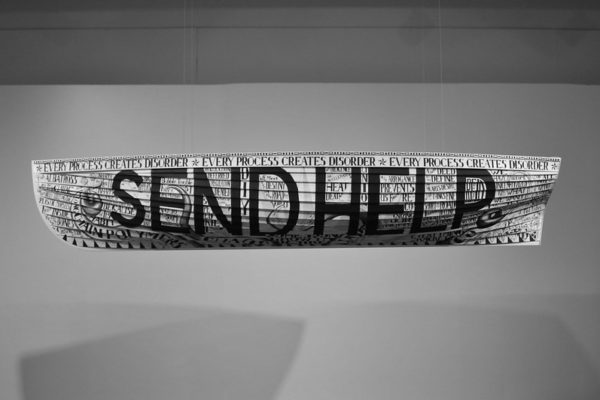As a past best of track and best of conference speaker, Day Kibilds indeed gets things done.
She began her session “Get. Things Done.” saying she’s not necessarily an expert in any one thing (sidebar: you are, Day). Rather, she said she’s well-versed in many things.
“There’s something I’ve learned to do over time – all the mundane stuff,” she explained. “The stuff around all of the things we do — the stuff that sends us to happy hour every day.”
Day added that her talk was not a “project management talk” because project management takes talent and skills and knowledge. Instead, she said, this talk is about the day-to-day. The things that get in the way of the cooler things we want to do.
This is brilliant. As Day shared tips for better managing things like meetings, documentation, version control, and email, we could begin to see how we can gain back time. We all know we waste a LOT of time on mundane details or with archaic processes, but Day’s presentation addressed this elephant in the room and recharged attendees about the idea of efficiency.
Day used a Mario Brothers world-map theme to guide us through this adventure, with levels for email, filenames, meetings, and other barriers between us and saving the princess (aka doing our jobs). Throughout the way, we gained more powers and lost a few things, but we came out on top!
For maximum impact, I highly encourage you to view the slides (and, depending on when you’re reading this, also listen to a recording) because Day is a delightful and engaging presenter. In the meantime, here are some key takeaways from her presentation:
Documentation
Documentation includes training, how-tos, and, as Day says, “the stuff you write that tells people how to do something.” She gave us a peek at actual naming conventions and file organization (or lack thereof) before showing us her solution: internal wikis. Wikis, she says, are searchable, taggable and browsable. You can tag them (vertically and horizontally) and add/search comments. Her institution uses Confluence, but she says there are plenty of free tools available.
Day suggests planning the wiki with growth in mind, and this includes being more open with permissions so that all can add to it. Making it user-friendly and pretty won’t hurt: call-outs, pictures, colors, files, emojis, etc. will all add to the experience.
Document Versions
Day shared with us a doozy of a filename which she described as just “one version of a scenario nightmare.” In today’s marketing, communications, and web shops, we collaborate. A lot. So Day’s inclusion of file naming conventions is a welcome ” real talk.” Here, her suggestion is simple: Use the cloud. By nature of platforms like Google Drive, you’ll still have on documents with versions rather than multiple files with meaningless names.
She also shared suggestions for limiting the number of versions and keeping control of documents. For instance, she says to send documents for review with only comment access, NOT edit access. This prevents many hands in the documents and also allows you to add pre-emptive comments that explain word choice. (That is something I’ve been doing for a while now and it truly makes a difference; she’s spot on that this practice prevents unnecessary back and forths.) Another suggestion is to have a 30-minute phone call with all stakeholders rather than have drafts out to multiple people at once.
(At this point in the presentation, our Mario skipped over worlds 3 and 4. Day explained, “We didn’t need to go to them. Pick your battles. Just take the critical path to finish your project. Preserve your energy.)
Scheduling Meetings
Perhaps one of the best Mario-themed analogies: meetings are the dark, damp, underworld. Day warns, “Never send an email that says, ‘what time works for you?’” Instead, she says, send two options. This practice will eliminate multiple emails.
Another solution Day found is that when she needs to schedule meetings with multiple people (at different times) for a project, she’ll send a cloud-based sign-up sheet — this adds some peer pressure to the situation. People will sign up quickly when they see colleagues already sign up for slots!
Another nugget: “You don’t need unanimous agreement to schedule a meeting.”
Day shared (as well as previously tweeted) a fantastic flowchart on how (and when) to set up meetings. Add that to your reference list!
Email Best Practices
“If people aren’t reading what you write, it is 100% your fault,” Day explained as she transitioned into her section on communicating with colleagues.
If you’re writing an email and it’s on the long side, she suggests asking: Should this a meeting? Should this be a training session? Should this be multiple emails?
And, if emails must be more than a few lines, she says to use formatting to your advantage. Make the most important part memorable. “If they only have two seconds, what do you want them to see?” she asks.
Finally, she asks us to stop being so polite. Just get to the point. For example, go with “Choose a date” rather than “If you could, when you get a moment, would you please…” She rationalizes this by telling us to think about calls to action: “Amazon doesn’t ask me to please pay.”
Day’s talk also covered taking good, practical meeting notes. Before closing, she reiterated, “These are practical, mundane, dumb tips. I know this is not mindblowing in any way… we never learn how to do the day-to-day.”
(Note: This presentation won best of track!)
IMAGE CREDIT: Flickr Creative Commons/Viewminder

